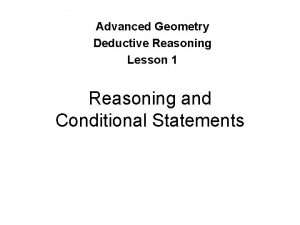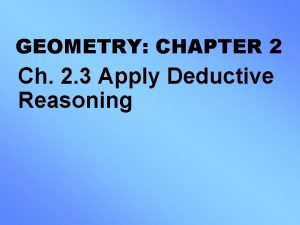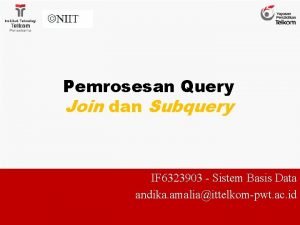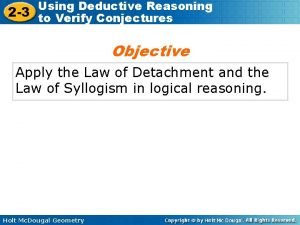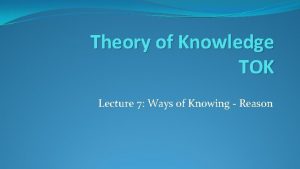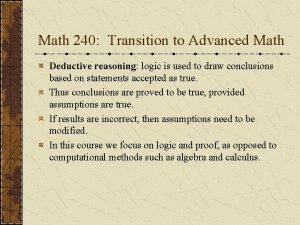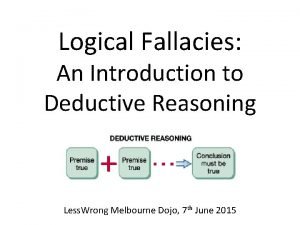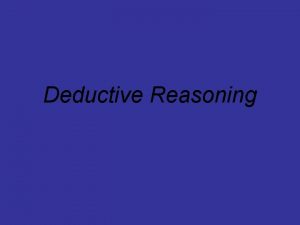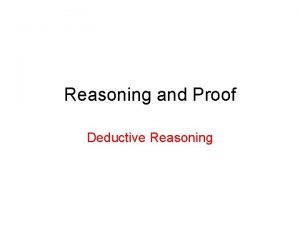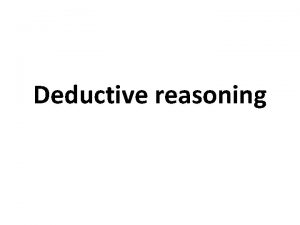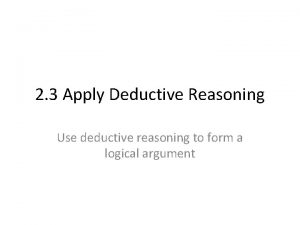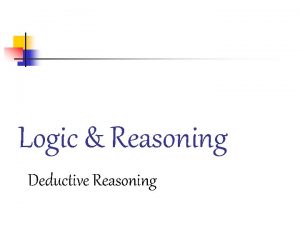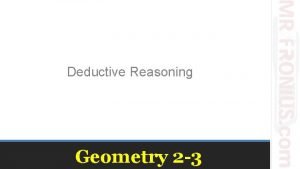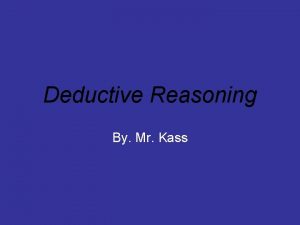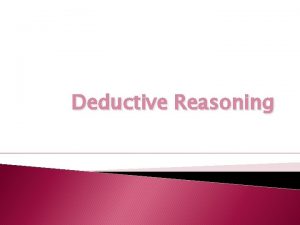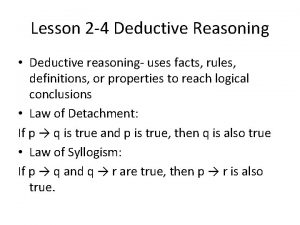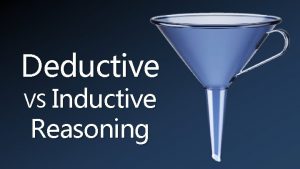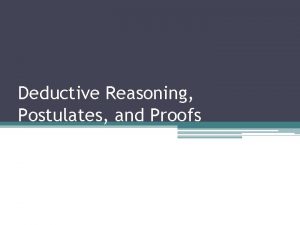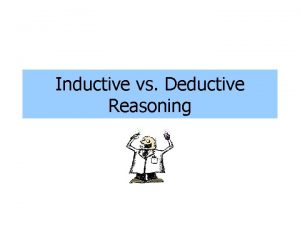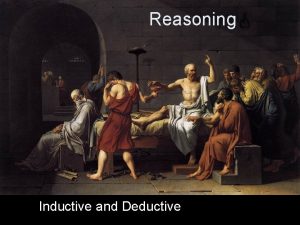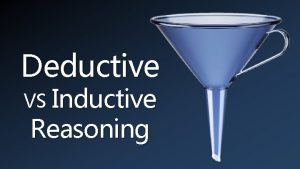Geometry Chapter 2 2 3 APPLY DEDUCTIVE REASONING















- Slides: 15

Geometry Chapter 2 2 -3: APPLY DEDUCTIVE REASONING

Warm-up Any Definition can be written as a Biconditional Statement. For Warm-up: Write some of our past vocabulary terms as Biconditional statements. Terms: Collinear Points Supplementary Angles Congruent Segments Complementary Angles Congruent Angles

2 -3: Apply Deductive Reasoning Objective: Students will be able to deductive reasoning to form a logical argument in order to reach a logical conclusion Agenda Ø Deductive Reasoning ØLaw of Detachment ØLaw of Syllogism ØInductive/Deductive Reasoning

Deductive Reasoning • Deductive Reasoning uses postulates, definitions, accepted properties, and the laws of logic to form a logical argument. • Laws of Logic • Law of Detachment • If the hypothesis of a true conditional statement is true, then the conclusion is also true.

Laws of Logic – Law of Detachment Then Mary will go to the movies tonight.

Deductive Reasoning • Deductive Reasoning uses postulates, definitions, accepted properties, and the laws of logic to form a logical argument. • Laws of Logic • Law of Syllogism • If hypothesis a, then conclusion b • If hypothesis b, then conclusion c • If hypothesis a, then conclusion c To sum it up, event a leads into event b, which then leads into event c. So overall, event a ultimately leads into event c.

Laws of Logic – Law of Syllogism • Examples: Use the Law of Syllogisms to write a new conditional statement that follows from the pair of true statements. a. ) If Rick takes Chemistry this year, then Jesse will be Rick’s lab partner. If Jesse is Rick’s lab partner, then Rick will get an A in Chemistry. Solution: If Rick takes Chemistry this year, then Rick will get an A in Chemistry

Laws of Logic – Law of Syllogism

Laws of Logic – Law of Syllogism • Examples: If possible, use the Law of Syllogisms to write a new conditional statement that follows from the pair of true statements. c. ) If a polygon is regular, then all angles in the interior of the polygon are congruent. If a polygon is regular, then all of its sides are congruent. Solution: A new statement cannot be made; Neither statement has a conclusion that is the other statement’s hypothesis.

Deductive and Inductive Reasoning • In Geometry, you will frequently use inductive reasoning to make conjectures by analyzing Patterns. • You will also use deductive reasoning to show whether these statements are true or false through the use of logical arguments. • You will need to be able to tell which type of reasoning is being used at any given time.

Deductive and Inductive Reasoning Conjecture: An even integer multiplied by any other integer always results in an even integer.

Deductive and Inductive Reasoning Final (Proven) Result: The product of an even integer and any other integer is always an even integer.

Deductive and Inductive Reasoning • Example: Decide whether inductive or deductive reasoning is used to reach the conclusion. Explain your reasoning. a. ) Each time Monica kicks a ball up in the air, it returns to the ground. So the next time Monica kicks a ball up in the air, it will return to the ground. Inductive Reasoning: A pattern is used to arrive at a conclusion b. ) All reptiles are cold-blooded. Parrots are not cold blooded. Sue’s pet parrot is not a reptile. Deductive Reasoning: Facts about animals and the laws of logic are used to reach a conclusion

Deductive and Inductive Reasoning • Example: Decide whether inductive or deductive reasoning is used to reach the conclusion. Explain your reasoning. c. ) Whenever it rains in the morning, afternoon baseball games are canceled. The baseball game this afternoon was not canceled. So, it did not rain this morning. Deductive Reasoning: The laws of logic are used to reach a conclusion d. ) Every time Tom has eaten strawberries, he has had a mild allergic reaction. The next time he eats strawberries, Tom will have a mild allergic reaction. Inductive Reasoning: The conclusion is based off a pattern of past occurrences.

HW 2 -3 Pgs. 82 #’s 1 -10, 16 -19, 21, 22, 25 -38 (EC) – 11
 Inductive vs deductive reasoning
Inductive vs deductive reasoning Every quiz has been easy. therefore, the quiz will be easy
Every quiz has been easy. therefore, the quiz will be easy Deductive reasoning definition
Deductive reasoning definition Deductive and inductive reasoning
Deductive and inductive reasoning Inductive vs deductive reasoning
Inductive vs deductive reasoning Inductive reasoning
Inductive reasoning Deductive reasoning geometry
Deductive reasoning geometry Inductive reasoning definition
Inductive reasoning definition Deductive reasoning geometry definition
Deductive reasoning geometry definition Cross apply vs outer apply
Cross apply vs outer apply Using deductive reasoning to verify conjectures
Using deductive reasoning to verify conjectures Hypothetico deductive method
Hypothetico deductive method Deductive reasoning math definition
Deductive reasoning math definition Deductive reasoning fallacy
Deductive reasoning fallacy Deductive
Deductive Inductive literature review
Inductive literature review






